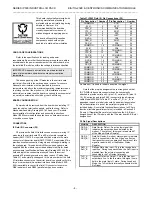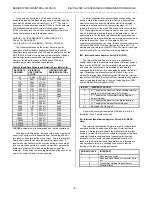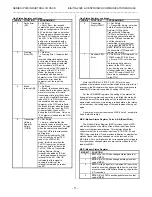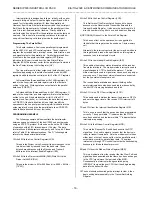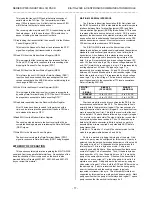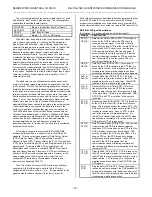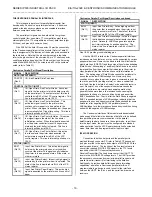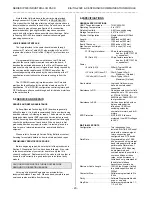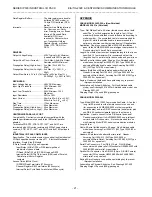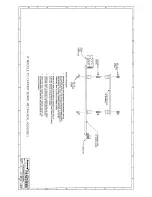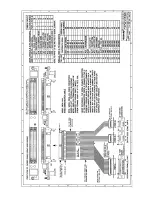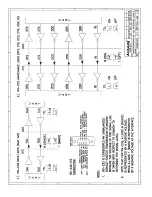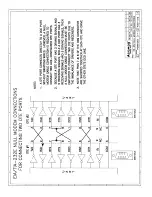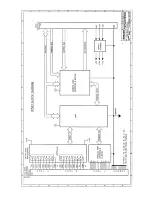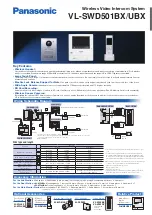
SERIES IP503 INDUSTRIAL I/O PACK EIA/TIA-232E & CENTRONICS COMMUNICATION MODULE
___________________________________________________________________________________________
- 12 -
MSR - Modem Status Register continued
MSR BIT
FUNCTION
4
CTS - the complement of the CTS* input from the
modem indicating that the modem is ready to
receive data. If the channel is in the loopback
mode (MCR bit 4 = 1), then the state of RTS in the
MCR is reflected
5
DSR - the complement of the DSR* input from the
modem indicating that the modem is ready to
provide received data to the serial channel receiver
circuitry. If the channel is in the loopback mode
(see MCR bit 4 description), then the state of DTR
in the MCR is reflected
6
RI - the complement of the RI* input from the
modem. If the channel is in the loopback mode
(see MCR bit 4 description), this bit reflects the
state of OUT1 in the MCR
7
DCD - the current status of the DCD* input from the
modem (a “1” indicates DCD* is asserted)If the
channel is in the loopback mode (see MCR bit 4
description), this bit reflects the value of OUT2 in
the MCR
An Asterisk (*) is used to indicate an active-low signal
Note that reading MSR clears the delta-modem status
indications (bits 0-3), but has no effect on the other status bits.
For the MSR & LSR registers, the setting of the status bits during
a status register read operation is inhibited (the status bit will not
be set until the trailing edge of the read)However, if the same
status condition occurs during a read operation, that status bit is
cleared on the trailing edge of the read instead of being set again
In Loopback Mode, when the modem status interrupts are
enabled, the CTS*, DSR*, RI*, and DCD* inputs are ignored.
However, a modem status interrupt can still be reflected by
writing to MCR bits 3-0 (see Loopback Mode Operation section
for details)
A power-up or system reset sets MSR bits 0-3 to 0 (bits 4-7
are determined by the corresponding input signals)
SCR - Scratch Pad/Interrupt Vector Register, Ports A & B
(R/W)
This 8-bit read/write register has no effect on the operation of
either serial channel. It is provided as an aide to the programmer
to temporarily hold data. Alternately, it stores the interrupt vector
for the serial port
If interrupt generation is desired, then this port is used to
store the interrupt vector for the serial port In response to an
interrupt select cycle, the IP module will execute a read of this
register for the interrupting port (see Interrupt Generation section
for more details)
LPT - Line Printer Data Register (Read/Write)
This register reads or writes the parallel data lines. This
register is either output only, or bi-directional, depending on the
state of the extended mode bit (bit 0 of the LEM register) and the
data-direction control bit (bit 5 of the LPC register)
If the extended mode bit is 0, then the compatibility mode is
selected and reads to the LPT register return the last data that
was written to the port, while write operations immediately output
data to the parallel data lines
If the extended mode bit is 1, then read operations return
either the last data written to the port (if the direction bit of the
LPC register is set to write/0), or the data that is present in the
port (if the direction bit is set to read/1)Write operations to this
port always latch data into the output register, but only drive the
parallel data lines when the direction bit is set to write
The following table summarizes the functionality of this port
based on the logic states of the extended mode bit and data
direction bit (bit 5 of LPC):
Extended Mode
Bit (LEM Bit 0)
Data Direction
Bit (LPC Bit 5)
Parallel Port
Function
0
X
PC/AT Mode - Output
1
0
PS/2 Mode - Output
1
1
PS/2 Mode - Input
LPS - Line Printer Status Register (Read Only)
This is a read-only status register that contains interrupt and
printer status of the line printer interface pins. These pins are
defined as follows:
Line Printer Status Register
LPS Bit
FUNCTION
PROGRAMMING
0
Reserved
Read as 1
1
Reserved
Read as 1
2
Printer
Interrupt Status
Bit (PRINT*)
When low, indicates that the
printer has acknowledged the
previous transfer with an ACKN
handshake (if bit 4 of LPC is set
to 1)This bit is set to 0 on the
active-to-inactive transition of the
ACKN* signal. The default value
is “1” and this bit is set to 1 after a
read of the status port
3
Error Status Bit
(ERR*)
Active low, corresponds to ERR*
input line state
4
Select Status
Bit (SLCT)
Corresponds to SLCT input line
state
5
Paper-Empty
Status Bit (PE)
Corresponds to the PE input line
state
6
Acknowledge
Status bit
(ACKN*)
Active low, corresponds to the
ACKN* input line state
7
Busy Status Bit
(BUSY*)
Active low, corresponds to the
active high BUSY input line state
An Asterisk (*) is used to indicate an active-low signal
Note that bits 0 & 1 are always high, bit 2 defaults to high,
and the state of bits 3-7 are dependent upon the printer device
inputs. Refer to Section 40 (Theory of Operation) for a detailed
description of the Centronics port signal functions
LPC - Line-Printer Control Register (Read/Write)
This is a Line-Printer Control register (LPC) used to control
the data direction of the parallel data lines and drive the printer
control lines. Write operations set or reset these bits, while read
operations return the state of the last write operation to this
register. The functions of these bits are defined as follows:




